OUR FORAY INTO PROVENCE REAL ESTATE CONTINUES WITH A SHEEPFOLD, A PARKING SPACE, A COURTYARD, AND A CAVE
This is the second in a series of posts about buying, renting, and selling our property in Provence.
Please note that, our homes, christened La Bonbonnière and L’Oustaloun, were purchased by a lovely family who continues to rent them both—for more information about these vacation homes as well as others, visit www.RentOurHomeInProvence.com
It was beginning to feel like Monopoly—do we buy Park Place so we can build on Boardwalk? I hoped one of us had a “GET OUT OF JAIL FREE CARD” card.
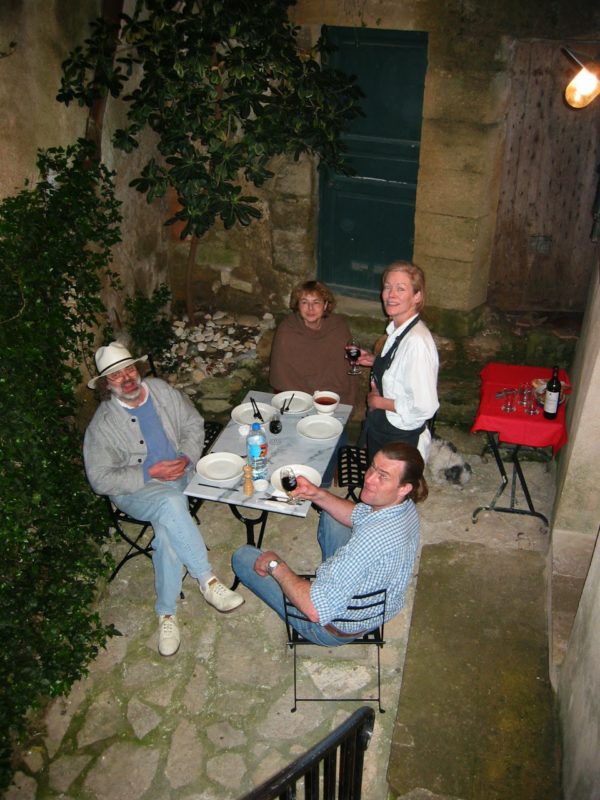 |
| We spent a lot of time in our courtyard. Photo by W.T. Manfull |
In this case, do we buy a bergerie in the neighboring building—a sheepfold, in English—and a parking space in order to keep “our” courtyard? Those who read Part I know it was this charming courtyard that stole our hearts and played an integral role in our decision to buy our maison village. But, it wasn’t really “ours.” It was part of the neighboring property.
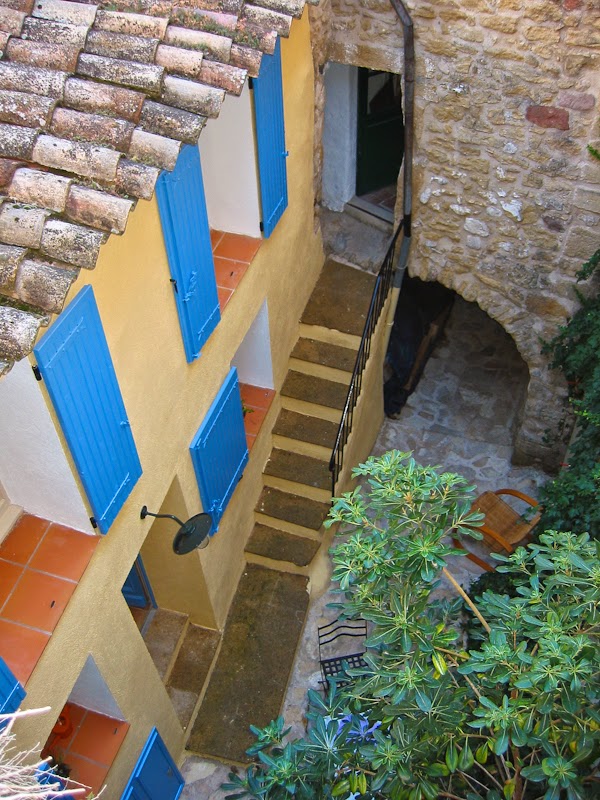 |
| View of the courtyard from the home of friends in the recently converted copropriété (condominium complex). Photo by W.T. Manfull |
We knew this, but for as long as anyone could remember, the owners of our petite maisons had enjoyed full access to it, filling it with their belongings including a table and chairs where they drank many…
aperitifs and pots of herbs from which they cut what was needed for their meals. We were to have the same arrangement with our purchase. However, the owner of the neighboring property died and his heirs opted to sell the huge home—including the courtyard—to developers who would convert the huge home into a copropriété (otherwise known as a condominium complex).
aperitifs and pots of herbs from which they cut what was needed for their meals. We were to have the same arrangement with our purchase. However, the owner of the neighboring property died and his heirs opted to sell the huge home—including the courtyard—to developers who would convert the huge home into a copropriété (otherwise known as a condominium complex).
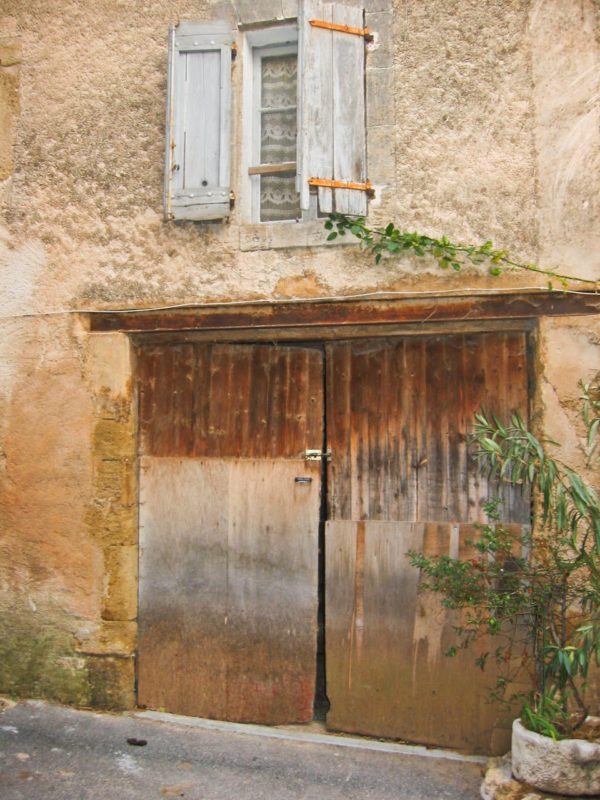 |
| Door to the former sheepfold. Photo by W.T. Manfull |
The developers, an amiable but savvy couple, recognized immediately, I am certain, the value of the courtyard to us. They did not offer to sell just the courtyard. Instead, feeling confident that we would not want to lose the courtyard that sat directly outside our doors and windows, they bundled it with the least attractive part of the whole building—a former sheepfold—and threw in a parking space.
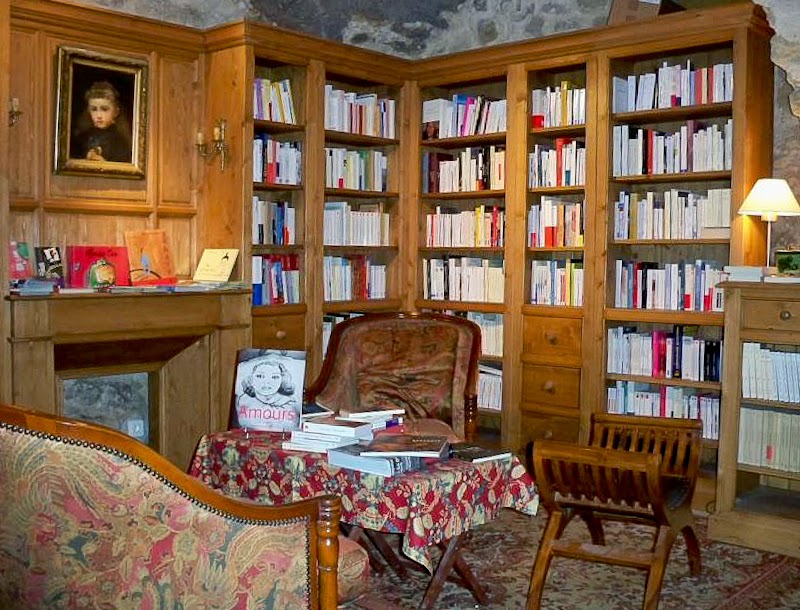 |
| One of the rooms in Le The dans l’Encrier (now closed) was originally a cave. Photo by W.T. Manfull |
I had seen renovation miracles performed in Lourmarin—what looked like nothing more than a hole in the wall at the beginning of the summer was transformed into an elegant shop or tea room by fall’s arrival. Even beautiful living spaces materialized out of the darnedest places.
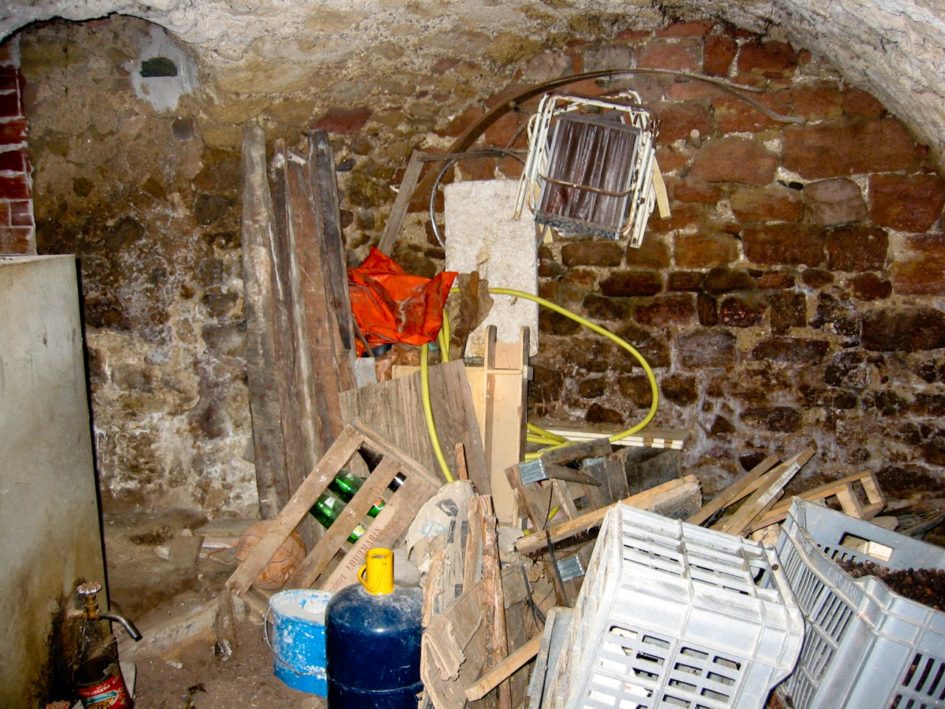 |
| The sheepfold we would eventually buy and name “La Bergerie”. Photo by W.T. Manfull |
“La Bergerie,” as we came to call the property in question, fell into a completely different category. As I mentioned in the last article, the earthen floor was covered with farm equipment and ancient sheep poop. A long feeding trough was filled to the brim with junk and a small chicken coop was full of hay. Several small nooks were appended to the main area and filled with more junk, including a toilet, attached to plumbing but no longer functioning.
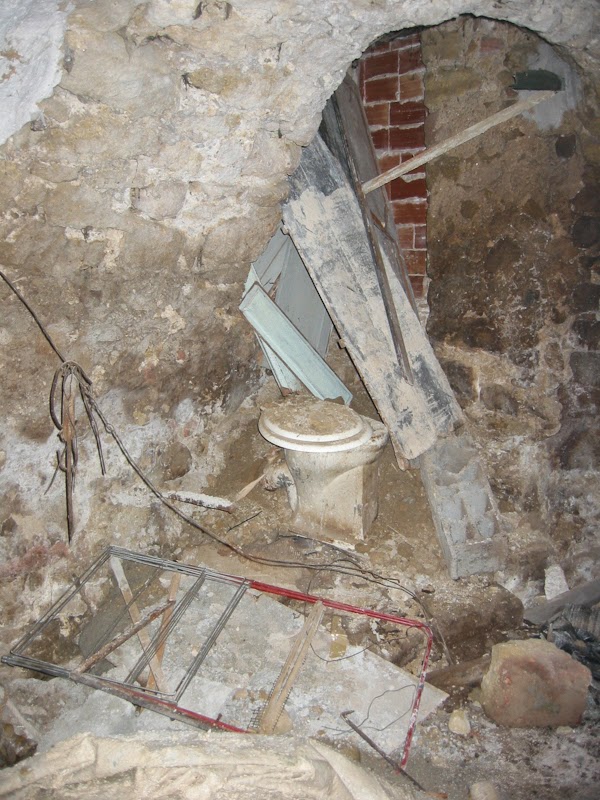 |
| La Bergerie. Photo by W.T. Manfull |
All this could be removed, of course, but one would still be left with a challenge: how to bring to life an oddly shaped hovel with varying heights—some with such low ceilings that the average person could not stand up—and one window (that faced our—or rather the—courtyard). Transforming La Bergerie into something inhabitable would indeed require a miracle. We were only hoping for small home that would open on to the courtyard.
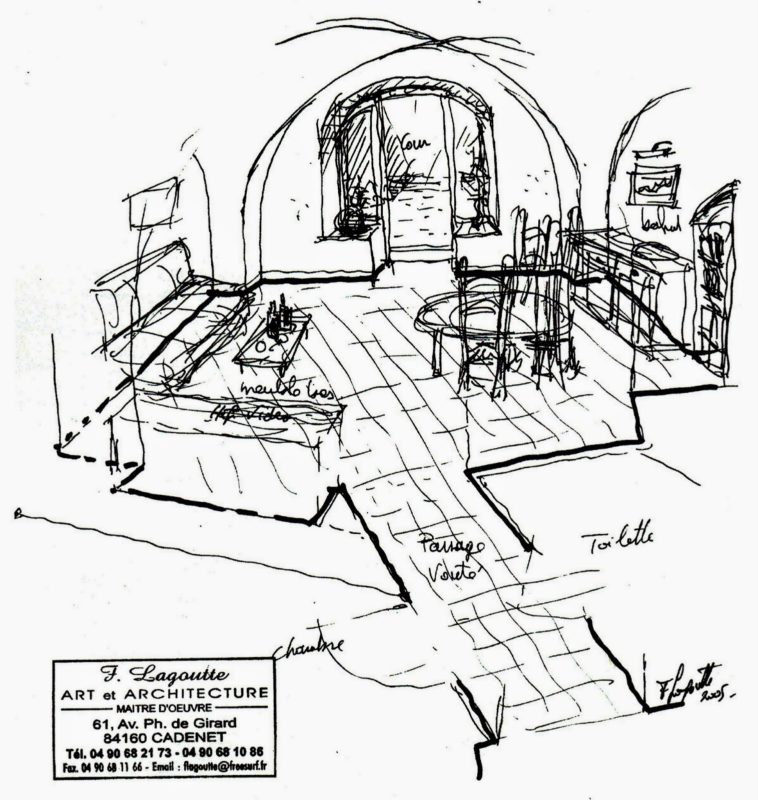 |
| Architectural plans for La Bergerie |
We solicited input from our contractor, electrician, plumber, and mason—they were still around, working on L’Oustaloun—and we looked at other projects (the aforementioned miracle transformations). Finally, we hired an architect to draw up some plans. We liked them.
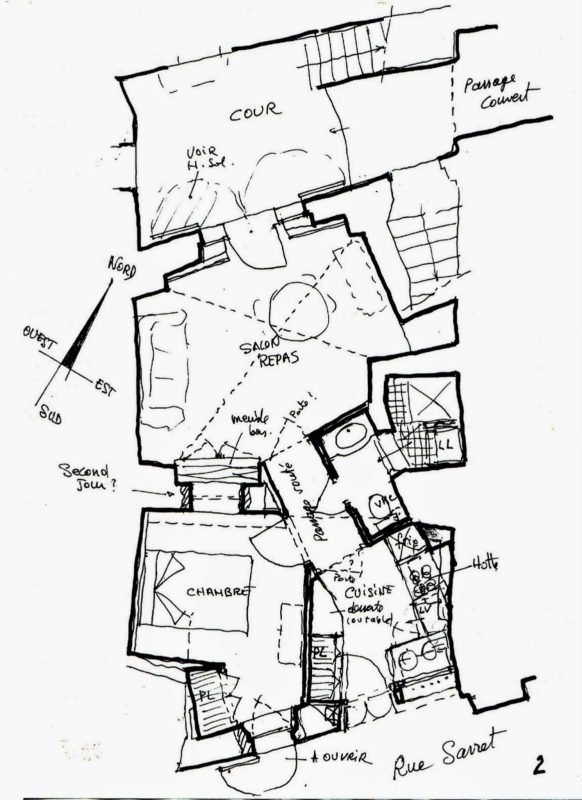 |
| Architectural plans for La Bergerie |
We weighed the pros and cons of owning a parking space (in a secure lot). This part of the sale stemmed from a relatively new municipal regulation—a good solution to the growing parking shortage in Lourmarin—that required all new residential development to be sold with parking spaces. We could use a secure parking space, we thought—it was increasingly difficult to find parking and we already had had two cars stolen back in 2002.
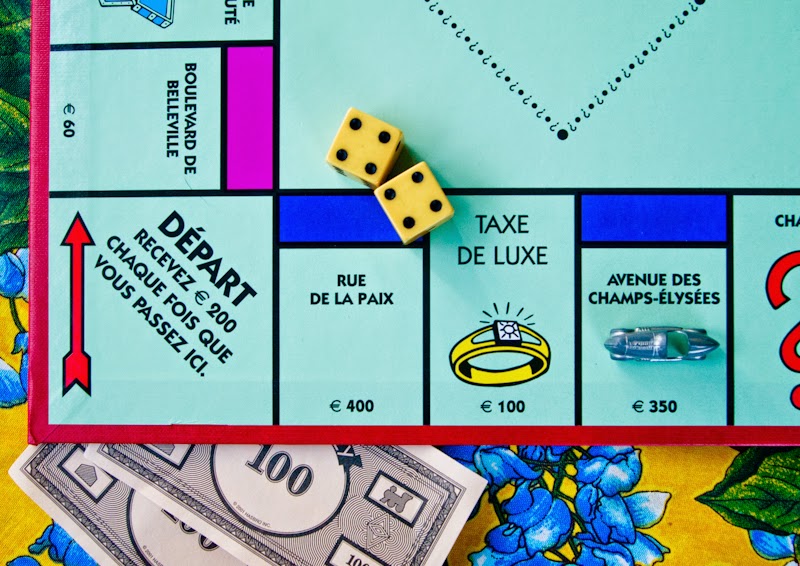 |
| Photo by W.T. Manfull |
As in Monopoly, we knew that we would not win if someone else owned the courtyard. We put a bid on the tripartite offering and I remember thinking that we had better pass “GO” soon and collect more than $200.00.
The next thing I remember, looking back on that spring, is stuffing my bra with euros while vacationing in Venice. We were en route to Lourmarin. and were out of space in both the money belt that Towny wore and the small purse that I draped around my neck, under my shirt. Buying the bergerie required that a certain sum be put forth “en liquide.” (That is, in cash.) So there we were in Venice, on a short stop before taking the train to Marseille, making an inordinate number of visits to the ATM in order to collect enough cash to pass under the table to the nice couple.
When we arrived in Lourmarin, weighed down with euros, we realized that we were not at all comfortable stashing that much cash under the mattress. Fortunately we were able to locate a friend with a safe who agreed to store the money until we made our rendezvous with the developers.
Cash under the table is a very common part of real estate transactions in France, so common we are told that some notaires leave the room—excusing themselves under some unrelated pretext, like “I will go make copies”–so that the transaction can take place. It was apropos that our transaction was executed over a bottle of rosé at the table in our courtyard. There, we counted the money, wrapped each stack with rubber bands, and raised our glasses in celebration. I felt relieved and lighter. Tchin-tchin!
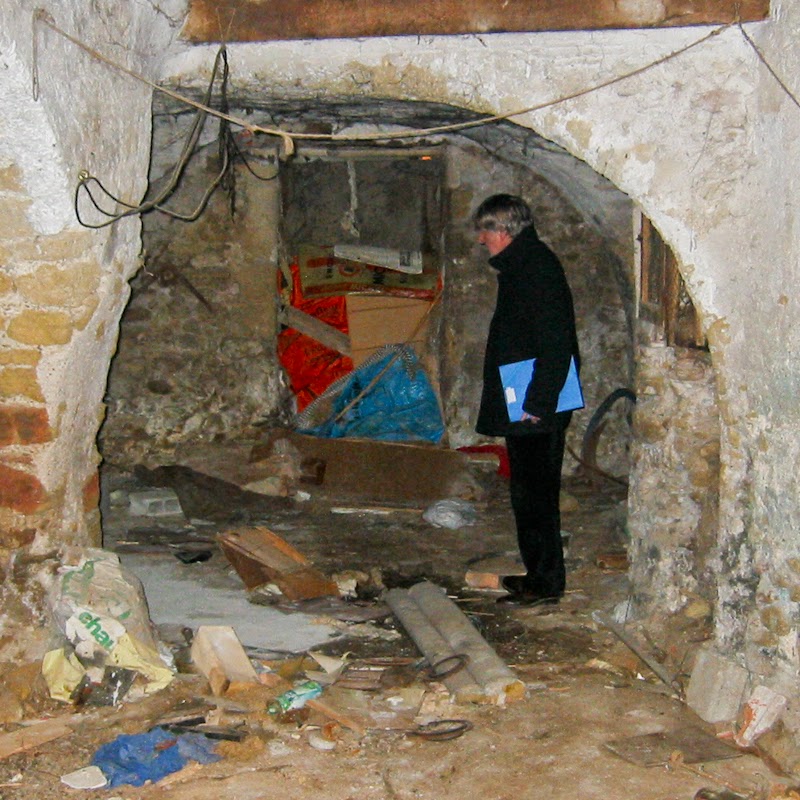 |
| Note the window that opens onto the courtyard. Photo by W.T. Manfull |
One of the first setbacks we experienced was that it would be not only cost prohibitive to construct an entrance to the courtyard but we would lose a significant portion of the courtyard to make way for the stairs on to it. So access to the courtyard from La Bergerie would require walking around the corner, entering the large green door, and coming in through the passageway. Not exactly convenient when having a dinner party (although we realized we could serve courses through the window!).
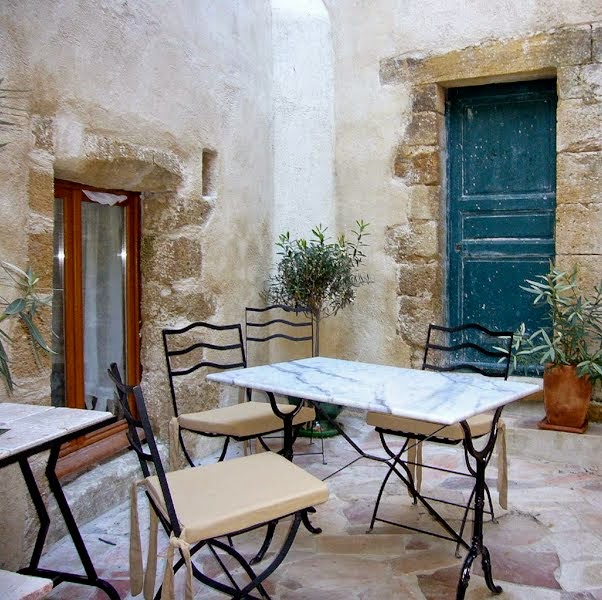 |
| Note the window that opens onto the courtyard. Photo by W.T. Manfull |
Then, we learned that we would have to build a “perimeter drain” along the sheepfold side of the courtyard to prevent water infiltration into La Bergerie, which, you might be thinking, would entail tearing up that portion of the courtyard. So, why not tear up the whole courtyard, raise it to accommodate the perimeter drain and cover the first stair to La Bonbonnière, thereby adding a small amount of precious space? And, while we are at it, let’s build a large planter because, by then, the developer had removed all the attractive greenery that leaned into the courtyard and grew up the sides of their building (to clean and resurface the wall). The sweet courtyard was looking rather barren.
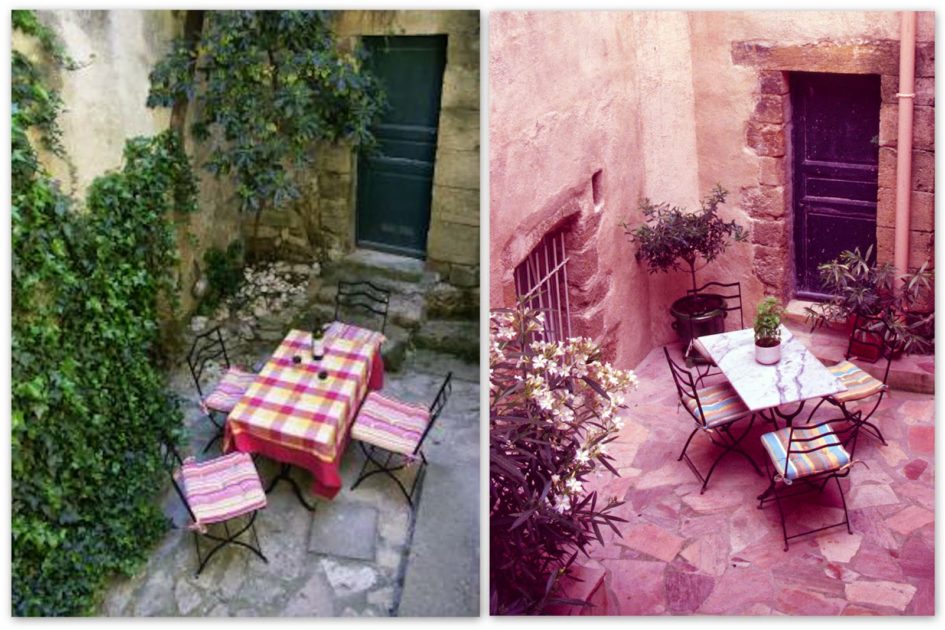 |
| Before and after photos of the courtyard. Photo by W.T. Manfull |
The plumbing in La Bergerie, as we were warned, was indeed proving to be very challenging. Lacking the benefit of gravity—almost all of the space was below ground level—a pumping system would have to be installed if we were to put the bathroom and kitchen where we wanted to put them.
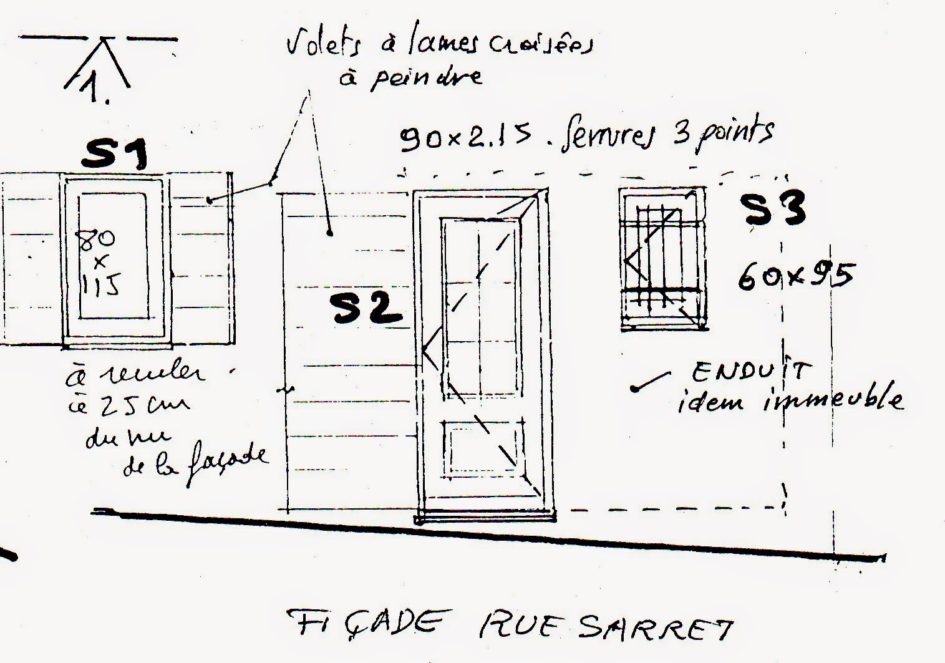 |
| Our proposed door and additional windows for La Bergerie |
Then, we got word that the mayor did not like the traditional Provençal door we had proposed and he said that the entrance had to be handicap accessible (which I would have enthusiastically endorsed except that the village itself, a product of the Middle Ages, is not remotely handicap accessible!).
With the bank account dwindling rapidly and feeling a little defeated, we began to entertain selling the space. Now that the farm equipment, chicken coop, sheep poops, and all the rest of the junk had been cleared out, it was easier to envision possibilities. Perhaps the space would better accommodate a shop or a gallery.
As we put out the word that La Bergerie may be for sale, we turned our attention to the other side of the courtyard, behind the dilapidated door next to Madame Bivet’s freshly painted door and right next to La Bonbonnière.
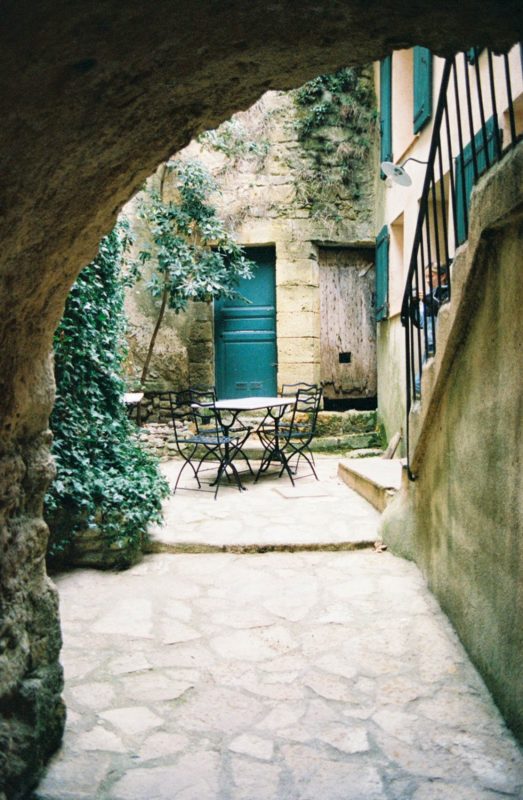 |
| Note the dilapidated door to the cave, on the right. Photo by W.T. Manfull |
When we were considering our initial plunge into Lourmarin real estate, we, naturally, inquired about who owned that property and what may lie behind that door (aside from the brood of cats that regularly sashayed though the courtyard and, we would later learn, occasionally pop into La Bonbonnière through the skylight).
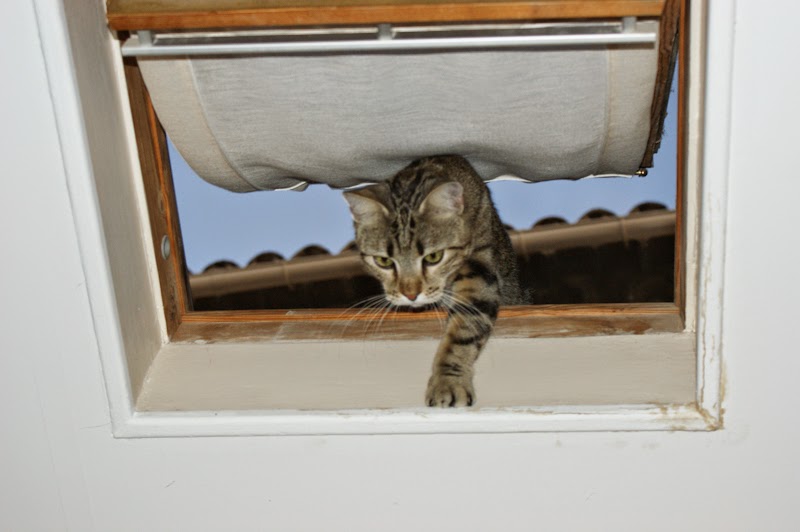 |
| A cat enters La Bonbonnière. Photo by W.T. Manfull |
We were told that it was part of the same large property, owned by the same elderly man who owned the courtyard (and whose later death, as we all know, set in motion a series of events that altered the course of our simple plans). It is a cave (pronounced “kav”), we were told, which, roughly translated, refers to a cellar, usually where wine is stored. Although this cave was on the same level as our two-story home, it was actually beneath the neighboring home, which was on higher ground than those homes on Rue de la Juiverie. La Bonbonnière had a cave beneath it (that belonged to another neighbor).
We were told that the owner used it for storage but “storage,” in no manner of speaking, captured what we eventually found behind the door. There was not a wine bottle in sight (except empty ones). No, this was a scene right out of the A&E television show, “Hoarders.” Impossible to venture further than a few footsteps inward, we stood at the doorway and stared, aghast. From the dirt floor to the beautiful vaulted ceiling, the cave was crammed full of stuff. There were so many layers, it looked that an archaeologist would be able to study the last five generations. There was more farm equipment and hay, broken up chicken coops, paint cans, tools, tiles, baskets, boxes, books, framed photographs, old lamps, a vacuum, chairs, a couple of mattresses, and what looked like a brass bed. We had no idea what the size of the room might be. And the stinky smell emanating from the room made us reluctant to attempt to explore further.
We had already tried to buy the cave when we bought La Bonbonnière and L’Oustaloun but were told that the elderly man would not sell it. After he died and the heirs sold the property to the developer, we assumed the cave would also go on the market. But it didn’t.
It turns out that this cave could be a case study in the cultural history of the Lourmarinois. There were no public records indicating who owned the cave, but it was widely known in the village that it belonged to the elderly man. It was not part of his property in the public record because, we learned, he won it in a local card game. Apparently, he had had the hand-written documentation to prove it because, when he died, the heirs took ownership of the cave, too. We were told on good authority, that they did not sell it to the developers because they bet on the Americans—that is, us—wanting to buy it.
One day, not long after buying the sheepfold, parking space, and courtyard, we got a call from the notaire, telling us that the cave was for sale. I recall watching my husband take the call—we were back home—and I could see he was visibly dumbstruck when he heard the price. We declined the opportunity, knowing full well that nobody else would swoop into buy it at that price—especially since the sale included the all the contents of the cave!!
Months passed before we heard from the notaire again . They lowered the price, he reported. We counter-offered. More months passed. We learned later that the long intervals between contacts were because the dozen or so heirs each had to be called and they all needed to reach an agreement which, apparently, was nearly impossible.
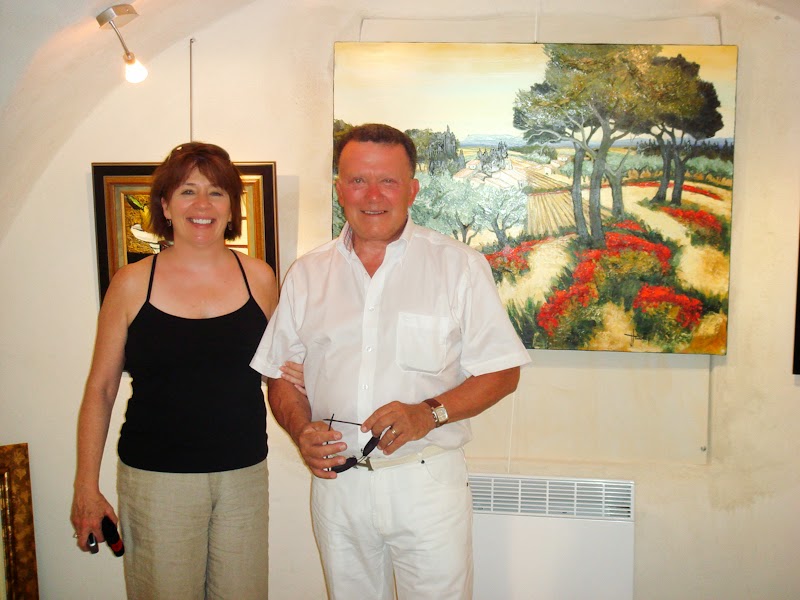 |
| Susan and one of the painters exhibiting his work in the new gallery. Note the painting covers the window to the courtyard. Photo by W.T. Manfull. |
In the meantime, a year after we bought La Bergerie, we sold it to a retired diplomat who planned to open a gallery. Like playing Monopoly, we would soon found ourselves buying more property to protect our initial assets—we reached an agreement on the price of the cave and were soon back in the notaire’s office!
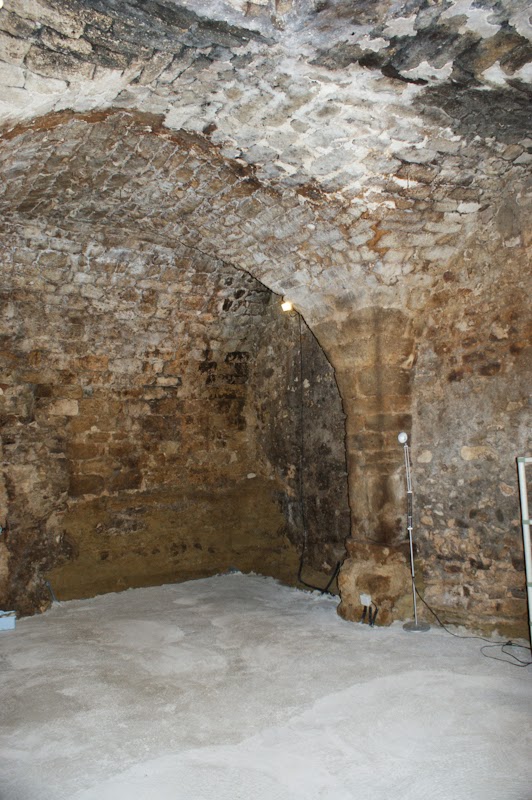 |
| La cave. Photo by W.T. Manfull |
It took ten truckloads to clear out the contents (that we had acquired as part of the purchase). Sadly, there were no treasures—the closest we came to one was the brass bed, which we gave to a neighbor. The cave turned out to be larger than we realized and the high vaulted ceiling was gorgeous.
Like a re-run of the last three properties, we brought the same contractor, mason, electrician, and plumber into the cave and entertained several ideas about what to do with it. In the end, we settled on a place to store our belongings including, of course, our wine.
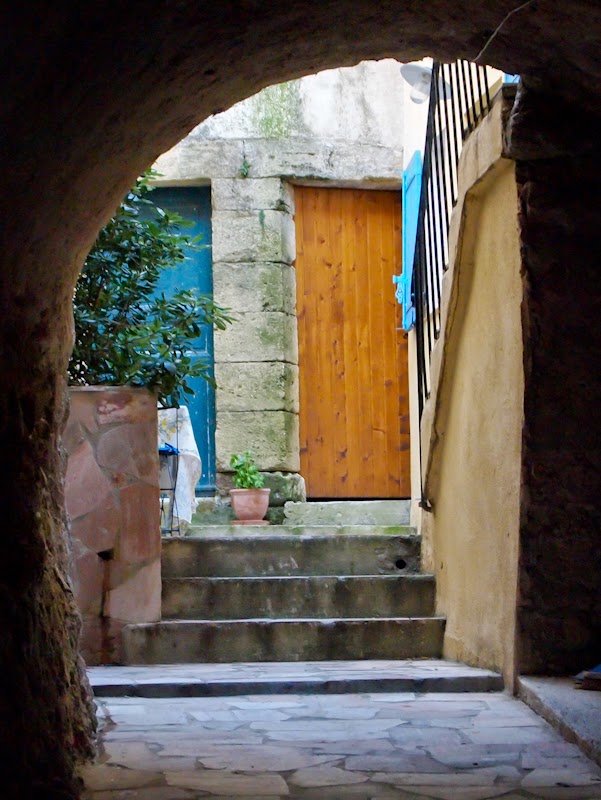 |
| Note the new door (on right) to the cave–no more cats in the cave! Photo by W.T. Manfull |
The first order of business was to change the unsightly door to the cave. It was probably the same door that came with cave all those years ago when young men played cards for caves. The new (longer) door effectively eliminated the cats and added some Provençal elegance to the courtyard.
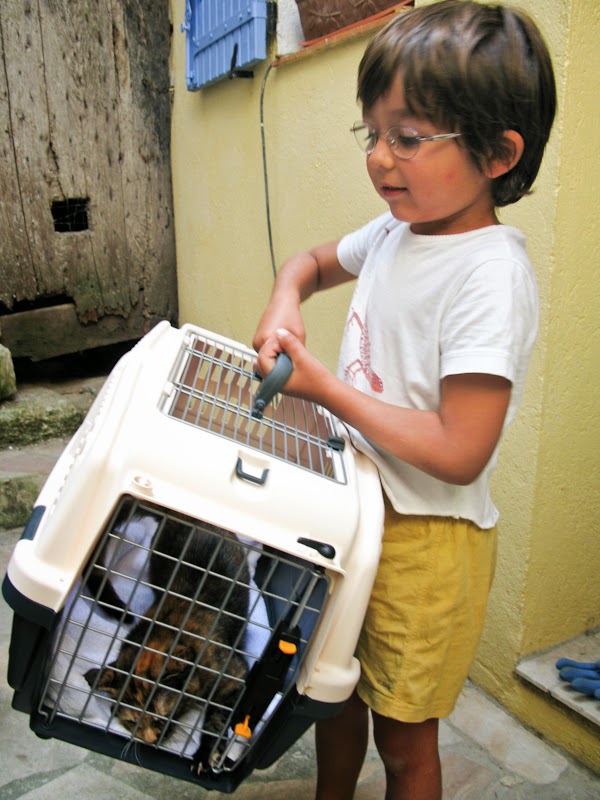 |
| One of the cats was adopted by a family from Paris. Photo by W.T. Manfull |
Renovating the cave was much simpler than our other projects. After power-washing the interior and pouring a cement floor, we were finished. C’est tout! We shouldn’t have been surprised when people starting dropping by to see the cave. It is a small village, after all. One person told us it was “the finest cave in all of Lourmarin.” I think we played our game of Monopoly well.
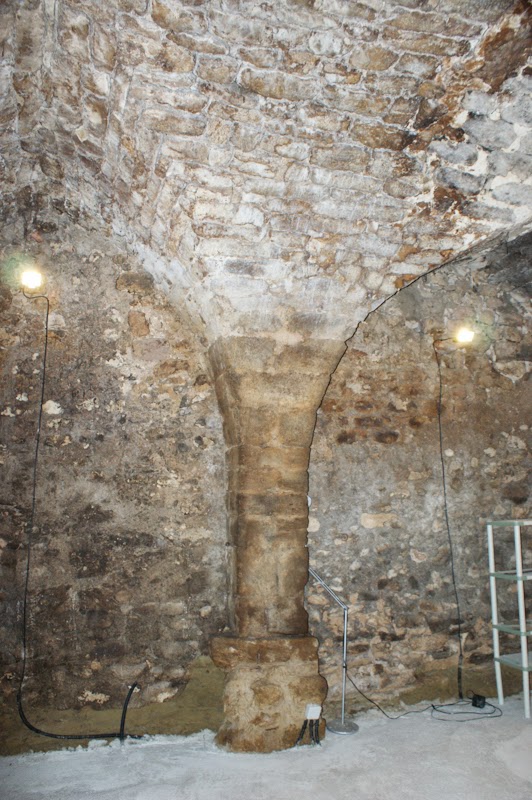 |
| La cave. Photo by W.T. Manfull |
_________________________________________
Notes:
Parts III and IV will follow and cover our experiences renting our homes to vacationers and then selling them.

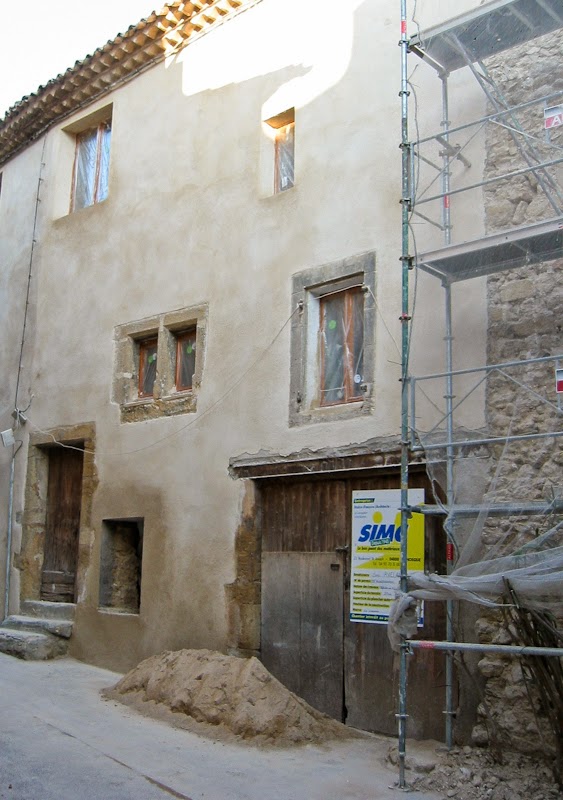
tres tres interessant
If you didn't have nerves of steel before you must have then now! I want to see the pics of your new place!
Absolutely a Monopoly marathon. You encountered every possible twisted Provencal real estate nightmare in one fell swoop! And lived to tell the tale. Bravo!
I am not sure it was nerves of steel as much as a lot of good wine and laughs. There were some moments though….Watch for the next post on renting our homes!
Over the years, my husband and I have thought of buying a place in Europe but never did. It might have been a smart thing. 🙂 I'm sure you miss all the fun that was had in that courtyard.